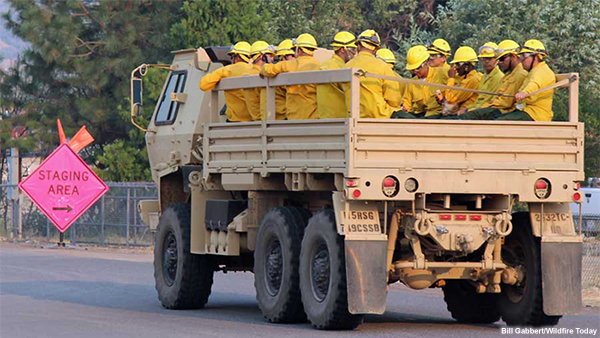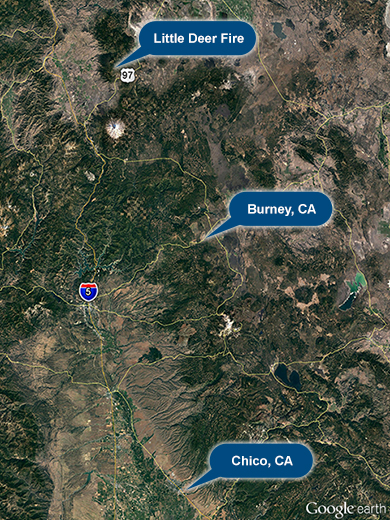Question 1.

The HRRR model guidance indicates thunderstorms developing between 16:00 and 18:00 PDT. The Storm Prediction Center has a general risk of convection for the day. One limiting factor is that recent thunderstorms have tempered fuels with the humidity not much below 30%, so you do not expect many new fire starts. The weather could be a problem for existing fires, but the risk for starting new fires is low. To view the full scenario click the “Data” link above.
The Operations Chief’s main question when he calls at 10:30 PDT for you is “What will the weather do today?”
Which of the following statements will you choose to best communicate the expected weather situation?
Question 2.
You have continued monitoring the situation for the last few hours. The latest HRRR model guidance shows thunderstorms developing between 16:00 and 18:00 PDT and staying mainly to the east of the fire. A recent IMET sounding shows the Lifted Index (LI) is already approaching -4 in Burney, CA and lightning has been detected near Chico from thunderstorms which have mostly been along the Sierra Crest all morning.

At 11:30 PDT, the Operations Section Chief from the Little Deer fire calls again. “The last time we spoke, you said that the storms could develop in the late afternoon today. Is that timing still correct? Where will the storms be in relation to the fire? How confident are you in the forecast?”
Question 2.
You have continued monitoring the situation for the last few hours. The latest HRRR model guidance shows thunderstorms developing between 16:00 and 18:00 PDT and staying mainly to the east of the fire. A recent IMET sounding shows the LI is already approaching -4 in Burney, CA and lightning has been detected near Chico from thunderstorms which have mostly been along the Sierra Crest all morning.

At 11:30 PDT, the Operations Section Chief from the Little Deer fire calls again.
“The last time we spoke, you were pretty sure that thunderstorms will develop today. But, you and other IMETs were arguing about the timing. I hope you sorted it out and have better timing information for me? Also, where will the storms be in relation to the fire? How confident are you in the forecast?
Question 2.
You have continued monitoring the situation for the last few hours. The latest HRRR model guidance shows thunderstorms developing between 16:00 and 18:00 PDT and staying mainly to the east of the fire. A recent IMET sounding shows the LI is already approaching -4 in Burney, CA and lightning has been detected near Chico from thunderstorms which have mostly been along the Sierra Crest all morning.

At 11:30 PDT the Operations Section Chief from the Little Deer fire calls again. “The last time we spoke, the Storm Prediction Center told you there was a low chance of storms today. You did not think the lightning threat was an issue for starting new fires, so you were holding off on the Red Flag Warning. How confident are you in that forecast? What happened with the model that was showing some thunderstorms? Does it give you some timing information you can share? Also, if the storms happen, where will they be in relation to the fire?
Question 3.

The Operations Sections Chief follows up with this question “So, you are fairly confident that the storms will most likely arrive around 16:00 but there is a chance they could impact the fire sooner. What will be the main impacts?”
Question 3.

The Operations Sections Chief follows up with this question “So, you made me wait an hour and you are still not sure when the storms will get over the fire. The model is telling you at 16:00, but some IMET balloon is telling you 13:00, and you believe it. This makes it harder to figure out what to tell my crews. I don’t think they will go for the balloon part to be honest. Do you at least have an idea of what will be the main impacts?”
Question 3.

The Operations Sections Chief follows up with this question “I waited an hour for you and the best you can do is tell me what is happening at Burney and Chico. I don’t really care what is happening there. I need to know what will be the situation over the Little Deer fire. You sound pretty sure that thunderstorms will reach the fire today sometime between noon and 18:00. That is a pretty big time window and is not helping me plan the work or what to tell my crews. Can you at least tell me what will be the main impacts?”
Feedback
Well done! Your communication effort was successful. You described the weather threat by relating it to the partner’s concerns. The timing, location, and confidence descriptions were appropriate and free of meteorological jargon. You also avoided mentioning Red Flag Warning when the criteria were not met. Lastly, you communicated the impacts well and offered how the Operations Chief could monitor the situation, which will assist with decision-making.
The storms developed around 14:30 and reached the fire. The National Guard troops were told to disengage and hike back to their trucks at 13:45. They were in their trucks and halfway back to their Incident Command Post (90 minute drive) when they got a bit of rain on them. But, a lightning strike was observed in the area they had been working on the fire at about 15:30. All crews were able to work as long as possible and get safely to the trucks and shelter.
You struggled communicating the forecast information to your partners. To be safe, the Operations Chief kept the crews close to the trucks and lost a fireline as a result.
Question 1
You described the weather threat appropriately by relating it to the partner’s main concern.
Question 1
The weather threat was described in terms of model performance and concerns from IMETs rather than relating it to the partner’s concern.
Question 1
The weather threat was described in terms of convection risk and the need for a Red Flag Warning rather than relating it to the partner’s concern. Additionally, mentioning the phrase Red Flag Warning could distract from your message because Red Flag Warning is not what you are expecting. It may be better to simply say, “Any thunderstorms should result in very few to no new starts because of the recent rain”.
Question 2
You expressed the timing, location, and confidence appropriately.
Question 2
The timing, location, and confidence level was obscured by meteorological jargon. That makes it difficult to select a course of action. Since the Chief waited an hour and the information makes it difficult to make a decision, this will increase the frustration level.
Question 2
The timing lacked the necessary temporal resolution and it was unclear how the geographical information relates to the area of the fire. That makes it difficult to select a course of action. Since the Chief waited an hour and the information makes it difficult to make a decision, this will increase the frustration level.
Question 3
You communicated the impacts well and offered a course of action to the Operations Chief to assist with decision-making. You also showed patience and understanding for the Chief’s concern despite the anger in the question.
Question 3
There was little description of the potential impacts and since the Little Deer fire has no IMET assigned, they will have to listen to messages about other fires rather than their own.
Question 3
Mentioning the phrase Red Flag Warning could distract from your message because Red Flag Warning is not what you are expecting. It may be better to simply say, “Any thunderstorms should result in very few to no new starts because of the recent rain”.
The use of words like “if” and phrases like “I am not comfortable” lead toward a low degree of confidence in the provided information.
While one always needs to be cognizant about message fatigue, sometimes the weather goes through rare cycles where impacts seem to occur on a daily basis. Given the risk to the firefighters exposed outside, it is important to take each event on its own merits. It is necessary to always make the maximum effort to ensure firefighter safety, despite our own biases.
Question 3
You communicated the impacts well and offered how the Operations Chief could monitor the situation, which will assist with decision-making. You also avoided mentioning Red Flag Warning when the criteria were not met.
Question 3
You selected a statement that defended your lack of certainty in the timing and did not acknowledge the Chief’s concern. This places you on opposite sides in the situation instead of being partners. There was little description of the potential impacts and since the Little Deer fire has no IMET assigned, they will have to listen to messages about other fires rather than their own.
Question 3
You selected a very defensive approach instead of acknowledging the Chief’s concern. This creates a confrontation instead of partnership in this difficult situation. In addition, the use of words like “if” and phrases like “I am not comfortable” lead toward a low degree of confidence in the provided information. Mentioning the phrase Red Flag Warning could distract from your message because Red Flag Warning is not what you are expecting. It may be better to simply say, “Any thunderstorms should result in very few to no new starts because of the recent rain”.
While one always needs to be cognizant about message fatigue, sometimes the weather goes through rare cycles where impacts seem to occur on a daily basis. Given the risk to the firefighters exposed outside, it is important to take each event on its own merits. It is necessary to always make the maximum effort to ensure firefighter safety, despite our own biases.
Try Again
End Simulation


